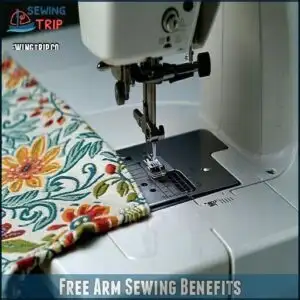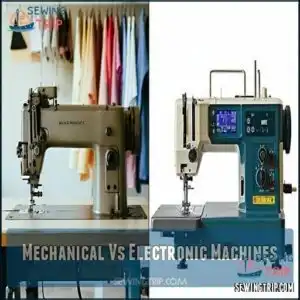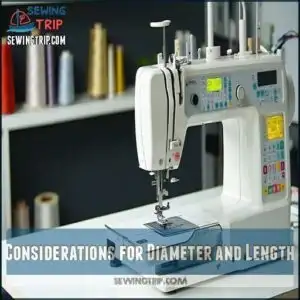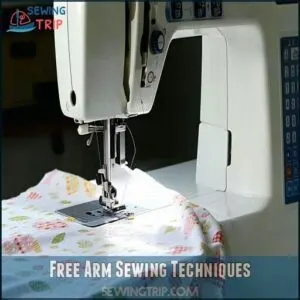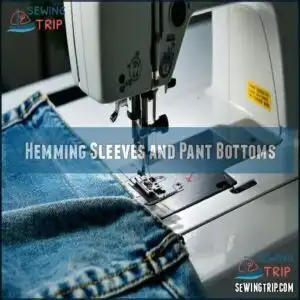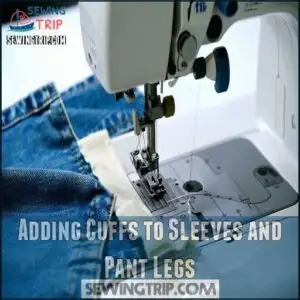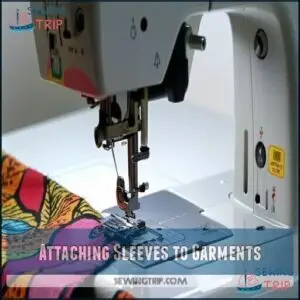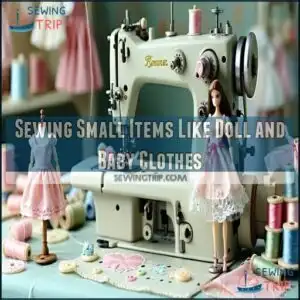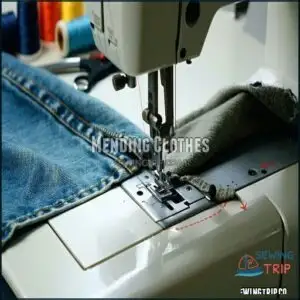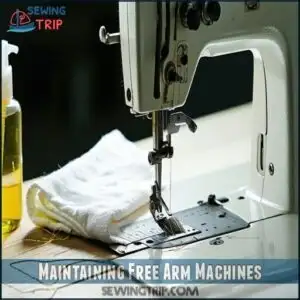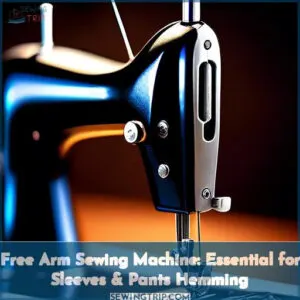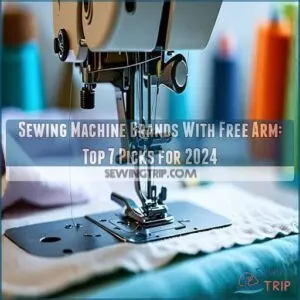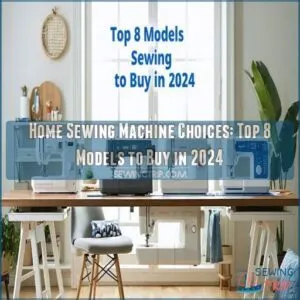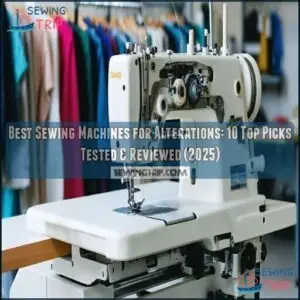This site is supported by our readers. We may earn a commission, at no cost to you, if you purchase through links.
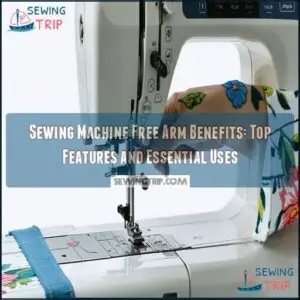
It lets you easily sew small, tubular, or curved areas like sleeves, cuffs, and pant legs without wrestling with extra fabric.
By reducing fabric manipulation, you’ll have better control and precision for neat stitching.
It’s like having a third hand to keep things steady—especially handy for hemming tight spaces or attaching collars.
Plus, the free arm speeds up your workflow, making it perfect for detailed projects or quick fixes.
Want to master those detailed seams? The free arm’s your ticket to sewing like a pro.
Table Of Contents
- Key Takeaways
- Free Arm Sewing Benefits
- Choosing Free Arm Machines
- Top 8 Free Arm Machines
- 1. Janome Fastlane Fuschia Portable Sewing Machine
- 2. SINGER Start 1304 Sewing Machine
- 3. Brother ST371HD Strong Sewing Machine
- 4. SINGER Tradition 2259 Sewing Machine Beginner
- 5. Brother XL-3750 Sewing Quilting Machine
- 6. Janome 2206 Beginner Sewing Machine
- 7. SINGER 1507WC Easy Sewing Machine
- 8. Janome 2212 Sewing Machine Bundle
- Free Arm Sewing Techniques
- Free Arm Sewing Applications
- Maintaining Free Arm Machines
- Frequently Asked Questions (FAQs)
- Conclusion
Key Takeaways
- You’ll easily sew tight spaces like cuffs, sleeves, and pant legs with the free arm, reducing fabric manipulation for precise results.
- Free arm sewing speeds up your workflow by minimizing stops and starts, making it perfect for detailed projects or quick repairs.
- It enhances control and precision, letting you stitch curved or small pieces smoothly with a professional finish.
- Proper machine maintenance, like cleaning and oiling, ensures your free arm operates smoothly and lasts longer.
Free Arm Sewing Benefits
With a free arm, you can easily handle tricky sewing tasks like cuffs, sleeves, and pant legs without constantly adjusting the fabric.
The free arm makes sewing sleeves and pant legs effortless, saving time and keeping your projects smooth and precise.
This feature streamlines your work, giving you better control and faster results.
Reduced Fabric Manipulation
Free arm sewing reduces fabric manipulation, giving you better fabric control when tackling tricky tasks like sewing tubular items or tight corners.
By eliminating the constant need to reposition your fabric, it makes sewing curves easier and prevents reduced snags.
Enjoy ergonomic sewing, posture benefits, and project versatility as you breeze through challenging designs with precision and ease.
Increased Sewing Speed
Switching from flatbeds to free arms can seriously boost your sewing speed.
Why? Less fabric handling means fewer stops and starts.
Here’s what helps:
- Tubular sewing: Handles sleeves and pant legs effortlessly.
- Reduced snags: Keeps threads flowing smoothly.
- Efficient hemming: Cuts down extra steps.
- Streamlined projects: Simplifies intricate tasks.
- Sewing efficiency: Less fiddling, more progress.
Enhanced Precision and Control
When sewing tight corners or small, curved areas, precision is everything.
Precision is key for sewing tight corners—free arm sewing lets you stitch with control, creating smooth, professional finishes.
The free arm sewing feature offers enhanced flexibility, letting you manage detail work and improve seam quality.
Its design helps with stitch accuracy and better fabric handling, giving you more sewing machine control.
Say goodbye to messy edges—cornering control becomes smooth and easy, ensuring professional results every time.
Choosing Free Arm Machines
When choosing a free arm sewing machine, focus on the type of machine and the specific features you need for your projects.
Consider factors like the arm’s size, additional functions, and whether a mechanical or electronic model suits your skill level, including the consideration of electronic features that may enhance your sewing experience.
Mechanical Vs Electronic Machines
If you enjoy simplicity and machine durability, mechanical sewing machines are ideal.
They’re affordable but lack automation.
Electronic sewing machines, however, offer stitch options and built-in conveniences like automatic needle threading, enhancing user experience.
While repairs for electronics may cost more, they save time.
Pick based on which sewing machine features align better with your routine—manual focus or modern ease.
Considerations for Diameter and Length
How do you choose the right free arm size? Arm diameter and length matter!
Smaller diameters handle tight spaces, great for doll clothes, while larger ones suit bigger garments. Longer arms manage more fabric, ideal for pant legs.
You can find products related to free arm diameter online.
Consider your project size, fabric type, and machine age to match your needs. Free arm sewing thrives on flexibility and fit!
Additional Features to Consider
Beyond size, think about sewing machine features that boost functionality.
Stitch options let you customize projects, while a needle threader saves time.
A responsive foot pedal offers smoother control, and extension tables expand working space.
Specialty feet enhance free arm sewing for tricky tasks.
These sewing machine accessories make your projects easier, maximizing sewing machine benefits with every stitch.
Consider also customer support options for long-term assistance.
Top 8 Free Arm Machines
Choosing the right free arm sewing machine can feel overwhelming, but finding one that suits your needs makes sewing much easier.
Here’s a quick look at eight reliable options packed with features to help you tackle any project.
1. Janome Fastlane Fuschia Portable Sewing Machine
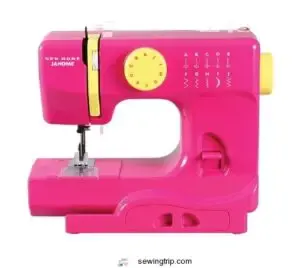
Lightweight and portable, the Janome Fastlane Fuschia is perfect for on-the-go projects or small spaces.
Weighing just five pounds, it includes 10 built-in stitches like straight, zigzag, and crescent, giving you versatility.
Its free arm makes sewing cuffs, sleeves, or pant legs a breeze, while the built-in accessory drawer keeps everything organized.
Safety isn’t overlooked with a finger guard on the presser foot.
Ideal for beginners or quick alterations, this machine balances ease of use with reliable features, boosting your sewing confidence effortlessly.
Best For: Beginners and those needing a lightweight, portable sewing machine for quick alterations or small projects.
- Compact and lightweight, easy to carry and store.
- Includes 10 versatile built-in stitches for various projects.
- Free arm allows for easy sewing of cuffs, sleeves, and cylindrical items.
- Limited to basic features compared to advanced sewing machines.
- Small size may not accommodate larger projects.
- Not suitable for heavy-duty fabrics or long-duration use.
2. SINGER Start 1304 Sewing Machine
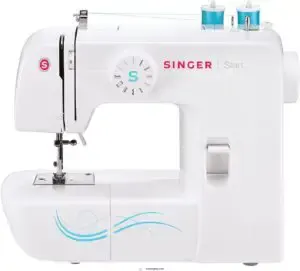
The SINGER Start 1304 sewing machine is a dependable choice for beginners, offering a free arm for tackling cuffs, sleeves, and other tricky areas.
It’s lightweight, making it perfect for small spaces or sewing classes.
With 57 stitch applications, preset stitch lengths, and an easy-to-use dial, setup feels like second nature.
The automatic bobbin winding system simplifies tasks, while included accessories like a zipper foot and darning plate add versatility.
Whether hemming or mending, this machine is an excellent tool for simple projects.
Best For: Beginners looking for a lightweight and affordable sewing machine for simple projects and basic tasks.
- Lightweight and portable, suitable for small spaces and sewing classes.
- Easy to use with preset stitch lengths and widths.
- Includes useful accessories like a zipper foot and darning plate.
- Limited stitch variety for more advanced projects.
- Task light may be insufficient for some users.
- Lacks detailed written instructions, relying on pictorial guides.
3. Brother ST371HD Strong Sewing Machine
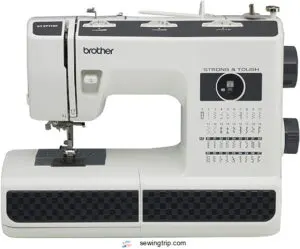
The Brother ST371HD sewing machine is a powerhouse designed for versatility and strength.
With 37 built-in stitches, an automatic needle threader, and a free arm, it’s perfect for tackling tough fabrics like denim or creating delicate projects like doll clothes.
The jam-resistant drop-in bobbin makes setup easy, while six included sewing feet handle various tasks effortlessly.
Users love its sturdy construction and smooth operation, even through thick seams.
It’s ideal for beginners or as a dependable backup machine for professionals.
Best For: Beginners, intermediate sewers, or professionals seeking a durable mechanical sewing machine for versatile projects.
- Buttonhole function requires manual adjustments and thread cutting.
- Not suitable for European voltage; designed for 120 volts.
- Lacks advanced features like a "down needle" button found on computerized machines.
- Sturdy construction ideal for tough fabrics like denim.
- Jam-resistant drop-in bobbin for hassle-free use.
- Includes 6 sewing feet and 37 built-in stitches for versatility.
4. SINGER Tradition 2259 Sewing Machine Beginner
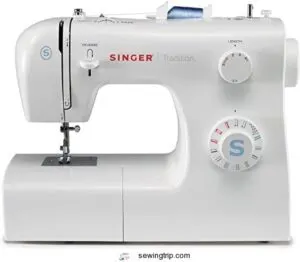
The Tradition 2259’s free arm is your go-to for sewing cuffs, sleeves, and pant hems like a pro.
Its sturdy metal frame guarantees durability, while the 19 built-in stitches let you explore creativity without overwhelm.
Adjustable stitch length and width give you control, whether you’re mending or making masterpieces.
Beginners will love the ease of its threading system, complete with guided arrows.
Lightweight and portable, it’s ready to follow wherever inspiration strikes—your reliable sidekick for projects big and small.
Best For: Beginners and hobbyists looking for an affordable, portable, and user-friendly sewing machine.
- 19 built-in stitches for versatility in projects.
- Sturdy metal frame ensures durability.
- Lightweight and portable with built-in carry handle.
- Limited power, only compatible with 110 volts.
- Some users report issues with thread tension.
- Side-loading bobbin can be inconvenient for some.
5. Brother XL-3750 Sewing Quilting Machine
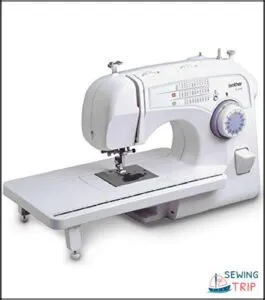
The Brother XL-3750’s versatility makes it a must-have for sewing enthusiasts.
Its free-arm design simplifies hemming sleeves, sewing cuffs, or mending tricky spots.
You’ll love the add-ons like an oversized quilting table, 73 stitch functions, and 7 presser feet, giving you endless creative options.
With its lightweight build and built-in handle, moving it around is effortless.
Plus, features like an auto needle threader and drop-in bobbin save time.
Perfect for beginners or hobbyists, it combines ease and creativity in one machine.
Best For: Beginners or hobbyists looking for an affordable, lightweight sewing machine with quilting features and versatile stitching options.
- Lightweight and portable with a built-in handle.
- Comes with quilting accessories like an oversized table and 7 presser feet.
- Features convenient tools like an auto needle threader and drop-in bobbin.
- Limited to 110-volt operation, not suitable for use outside 120V AC systems.
- May not offer enough advanced features for experienced or professional users.
- Plastic construction may feel less durable compared to higher-end machines.
6. Janome 2206 Beginner Sewing Machine
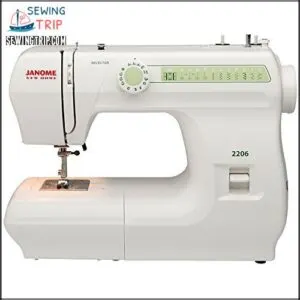
The Janome 2206 Beginner Sewing Machine keeps things simple yet effective, making it perfect for starting your sewing journey.
With a free arm, you can easily tackle sleeves, cuffs, and other tricky spots.
Its mechanical design offers six built-in stitches, a four-step buttonhole, and front dial controls for easy adjustments.
It’s compact and portable, so storage or moving around is hassle-free.
Durable and user-friendly, this machine balances reliability and performance, making it a trustworthy companion for your basic sewing needs.
Best For: Beginners or casual sewists needing a simple, reliable machine for basic projects.
- Easy to use with beginner-friendly features.
- Compact and portable design for convenience.
- Offers six built-in stitches and a four-step buttonhole.
- Limited advanced features may not suit experienced sewists.
- Not suitable for heavy-duty sewing projects.
- Requires regular maintenance for optimal performance.
7. SINGER 1507WC Easy Sewing Machine

If you’re after simplicity, the SINGER 1507WC delivers with ease.
It’s beginner-friendly and includes eight built-in stitches, covering essentials like straight and zigzag patterns.
The free arm makes sewing cuffs, sleeves, and smaller projects hassle-free, while its compact design guarantees portability.
Snap-on presser feet expand creative freedom, and adjustable stitch settings let you customize your work.
Plus, the included canvas cover protects it from dust.
Whether mending or tackling new projects, this machine’s functionality suits everyday sewing needs perfectly.
Best For: Beginners and hobbyists looking for a portable, easy-to-use sewing machine for everyday projects.
- Free arm for sewing cuffs, sleeves, and small projects with ease.
- Compact and lightweight design for portability.
- Snap-on presser feet and adjustable settings for creative versatility.
- Limited to 110-volt power supply, restricting use outside the US and Canada.
- Only eight built-in stitches, which may not meet advanced needs.
- Basic features may not appeal to experienced sewers.
8. Janome 2212 Sewing Machine Bundle

The Janome 2212 Sewing Machine Bundle is perfect for sewers who want versatility without hassle.
With 12 built-in stitches, a four-step buttonhole, and a free arm, it covers many projects, from hemming cuffs to mending pants. It’s lightweight, portable, and includes bonus accessories like presser feet, needles, and bobbins, making it beginner-friendly.
The adjustable stitch width and length add flexibility, while the drop feed lets you experiment with techniques.
This machine is also suitable for beginners due to its simple design and ease of use. Durable and reliable, it’s a great choice for home sewing and crafting.
Best For: Beginners and casual users seeking a user-friendly, portable sewing machine for home projects and crafts.
- Lightweight and portable with a built-in carrying handle.
- Includes 12 built-in stitches and a four-step buttonhole for versatility.
- Comes with a bonus accessory bundle for added value.
- Not suitable for industrial or heavy-duty sewing tasks.
- Limited to 12 built-in stitches compared to advanced models.
- Requires regular maintenance, like oiling, for optimal performance.
Free Arm Sewing Techniques
Using a free arm effectively can make tricky sewing tasks, like hemming sleeves or stitching cuffs, much easier.
With the right setup and a few techniques, you’ll be able to handle small, curved, or tight pieces with precision and control.
Preparing The Sewing Machine
Before enjoying the sewing machine benefits like precision and speed, prep your machine properly.
Start by threading the machine, ensuring smooth flow. Adjust the tension settings for fabric type, select the right stitch, and check the needle choice.
Proper threading is key, so consider buying quality sewing thread.
Keep your workspace ergonomic and organized.
These steps activate the full sewing machine functionality, making the free arm even more effective.
Techniques for Sewing With a Free Arm
Once your machine is prepped, let the free arm simplify sewing sleeves, cuffs, and pant legs.
Slide narrow items onto the arm for better fabric manipulation. Use topstitching techniques for smoother edges and secure stitches carefully.
Adjustable presser feet enhance precision. Free arm sewing offers greater control, especially for detailed projects requiring finesse in tight spaces.
It’s that straightforward!
Common Mistakes to Avoid
Don’t skip stitching basics! Ignoring tension problems, wrong needle choice, or improper presser feet setup can ruin stitches.
Always secure stitches at the start and end to prevent unraveling. Watch fabric feed—forcing it risks snags.
Pre-washing techniques help avoid shrinkage.
Keep sewing machine maintenance in check; lint buildup invites trouble. These sewing tips guarantee smooth sewing machine usage without unnecessary frustrations!
Free Arm Sewing Applications
You’ll find the free arm incredibly useful for tasks like hemming sleeves, attaching cuffs, or mending clothes.
It’s designed to make sewing small, curved, or tubular pieces much easier and more precise.
Hemming Sleeves and Pant Bottoms
Hemming sleeves and pant bottoms is simpler with free arm sewing.
Slide fabric over the arm for easy access to tight spots.
Use hemming techniques like measuring accurately and selecting the right stitch for fabric types.
Prevent puckering by adjusting tension and guiding material smoothly.
Whether sewing sleeves or pant legs, precise stitching guarantees neat finishes and professional-looking results.
Adding Cuffs to Sleeves and Pant Legs
Adding cuffs to sleeves and pant legs is simpler with a free arm.
Slide the fabric onto the arm, reducing fabric twists.
For a professional cuff finish, match cuff patterns and secure cuff edges evenly.
Explore cuff style variations to suit different garments.
Free arm sewing offers control, ensuring precise results for sewing cuffs on intricate or curved surfaces.
Attaching Sleeves to Garments
Attaching sleeves to garments is easier with a free arm sewing machine.
By aligning the sleeve ease with armhole shaping, you’ll get smooth and professional finishes.
Focus on securing shoulder seams first, then guide the fabric gently around the free arm.
This method simplifies garment construction, making sewing sleeves precise and hassle-free, especially when adding delicate cuff attachments.
Sewing Small Items Like Doll and Baby Clothes
Sewing doll or baby clothes can feel tricky, but free arm sewing simplifies things.
It’s perfect for sewing small spaces and achieving scale accuracy with miniature patterns.
Focus on fabric choices suited for tiny trims, and don’t forget seam allowances for clean edges.
The free arm helps you handle delicate fabrics and precise details effortlessly.
Mending Clothes
Clothing repair gets simpler with free arm sewing. Fixing tears and holes or reinforcing seams feels less intimidating when your sewing machine’s free arm offers better access.
Try these techniques:
- Patch pants’ knees with minimal fabric bunching.
- Repair tears in curved areas like elbows.
- Cover small holes seamlessly.
- Reinforce fraying garment edges.
- Simplify seam repair on tricky spots.
These methods can help make clothing repair easier and more efficient, allowing you to extend the life of your garments with minimal effort.
Maintaining Free Arm Machines
Keeping your free arm sewing machine in great shape doesn’t take much effort but makes a big difference in how well it performs.
With regular cleaning, oiling, and prompt attention to common issues, you’ll keep it running smoothly for years to come, which is a result of regular maintenance.
Regular Cleaning and Oiling
If you want your sewing machine running smoothly, make regular cleaning and oiling a habit. Remove lint and thread buildup after every few hours of use.
Clean under the needle plate and bobbin case gently. Refer to the manual for safe oiling frequency to avoid overdoing it. Consistent maintenance guarantees long-lasting performance.
To keep things running smoothly, consider the correct application of lubricant.
| Task | Frequency | Tool Needed | Tip |
|---|---|---|---|
| Lint Removal | After each project | Small brush | Focus on bobbin and feed dogs |
| Oiling Frequency | Monthly | Sewing machine oil | Check manual for specific spots |
| Component Care | Weekly | Damp cloth | Avoid water near electronics |
| Thread Buildup | Every use | Tweezers | Remove carefully to prevent damage |
By following these steps and maintaining your sewing machine, you will ensure it continues to perform at its best, providing you with years of reliable service and helping you to create professional-looking projects with ease and precision.
Addressing Common Issues
A sewing machine’s free arm needs regular attention to avoid trouble.
Look out for lint buildup, cutter problems, or loose parts that disrupt smooth operation. Tangled threads and thread jams often stem from improper stitching or debris.
Keep the area clean, remove lint frequently, and make certain parts are tight.
Regular cleaning, including addressing sewing machine maintenance, is vital for peak performance. This quick troubleshooting keeps your sewing frustration-free.
Seeking Professional Help When Needed
When troubleshooting doesn’t fix persistent jams, unusual noises, or stitching problems, it’s time to consult a certified technician.
Complex repairs—like electronic malfunctions or deep mechanical issues—require expert care. Don’t wait until things worsen.
- Contact customer service if repairs are under warranty.
- Find a reliable technician for thorough inspections.
- Avoid DIY fixes that could damage your sewing machine further.
Frequently Asked Questions (FAQs)
What is a sewing machine free arm?
Imagine sewing without limits—a free arm gives you that.
It’s a removable or extended part of the machine designed for hard-to-reach areas, making sewing cuffs, sleeves, and tight spots easier and faster.
Why do I need a free arm?
You need a free arm to handle tight spaces like sleeves or cuffs with ease.
It’s perfect for sewing tubular items, detailed work, and tricky angles, giving you precision and flexibility for creative projects.
What can you do with a free arm machine?
You can hem pants, sew cuffs, attach sleeves, or fix hard-to-reach areas like collars.
The free arm handles small, curved, or tubular items easily, giving you more control for detailed and precise work.
What is the best free arm sewing machine?
Did you know 95% of modern sewing machines include a free arm?
For versatility, try the Brother ST371HD—it’s durable, with 37 stitches, an automatic needle threader, and perfect for working on cuffs, sleeves, or collars.
What is the difference between a free arm and a flatbed sewing machine?
A free arm sewing machine excels at sewing cylindrical or tight areas like sleeves, while a flatbed offers a larger surface for general sewing.
Free arms simplify tricky spots; flatbeds handle bigger, flat projects better.
How Do I Convert My Flatbed Machine to Free Arm Mode?
Slide off the flatbed attachment to expose the free arm of your sewing machine.
If it’s not detachable, check your manual.
Some machines require specific adjustments or accessories to switch into free arm mode.
What is the function of the arm on a sewing machine?
An arm on a sewing machine acts as a bridge, holding your fabric steady while stitching.
It lets you sew curved or tubular items, like sleeves or pants, easily.
Think precision, patience, and perfect stitches!
What benefits did the sewing machine have?
The sewing machine revolutionized sewing by making it faster, more precise, and less labor-intensive.
It freed you from hand-stitching every detail, improved accuracy, and let you focus more on creativity and intricate designs.
Do all sewing machines have a free arm?
Not every sewing machine includes a free arm.
Older or simpler models might skip it, while most modern machines have one.
If you sew sleeves, cuffs, or tiny projects, it’s a game-changer worth considering.
How does a free arm assist with quilting?
Quilting with a free arm feels like adding a secret weapon to your toolkit.
It lets you easily maneuver fabric, stitch curved sections, and handle tricky areas, especially on detailed quilts or smaller projects.
Conclusion
A free arm on your sewing machine blends convenience with precision.
It’s great for small projects like cuffs and doll clothes, but also tackles tricky seams with less fabric fuss.
Sewing tight spaces becomes faster, smoother, and neater.
Whether you’re hemming pants or attaching sleeves, the free arm saves time and effort.
Choosing the right machine and maintaining it guarantees long-term benefits.
Harness the sewing machine free arm benefits to elevate your skills and finish projects like a pro with precision.

